Dark and moody interior design focuses on comfort, intimacy, and drama. This style offers a refreshing escape from bright modern spaces by creating cozy atmospheres that feel like retreats.
Deep colors like navy, charcoal, and forest green form the foundation, while varied textures add dimension and warmth.
Strategic lighting becomes crucial, with layered sources creating pools of illumination that highlight architectural features and treasured objects.
The result? Spaces that feel refined yet comforting—enveloping you in a sensory experience that bright interiors cannot match.
This design approach modifies ordinary rooms into extraordinary sanctuaries.
Understanding the Dark and Moody Visual
The dark and moody design stands out through deep colors, controlled lighting, and rich textures. This style creates spaces that quickly trigger emotions, using shadows and contrast to build an atmosphere.
The appeal comes from how these spaces wrap you in comfort. Dark walls make rooms feel cozier and more private – like the outside world.
The deep tones and soft lighting create a clean, grown-up feel.
More people now want homes that separate them from the busy world. The shift from all-white, bright rooms to darker, subdued spaces shows changing tastes.
People are moving away from bare, open designs toward more depth and character spaces. Dark design creates rooms that feel personal and meaningful.
Selecting the Right Colors for Dark and Moody Interiors
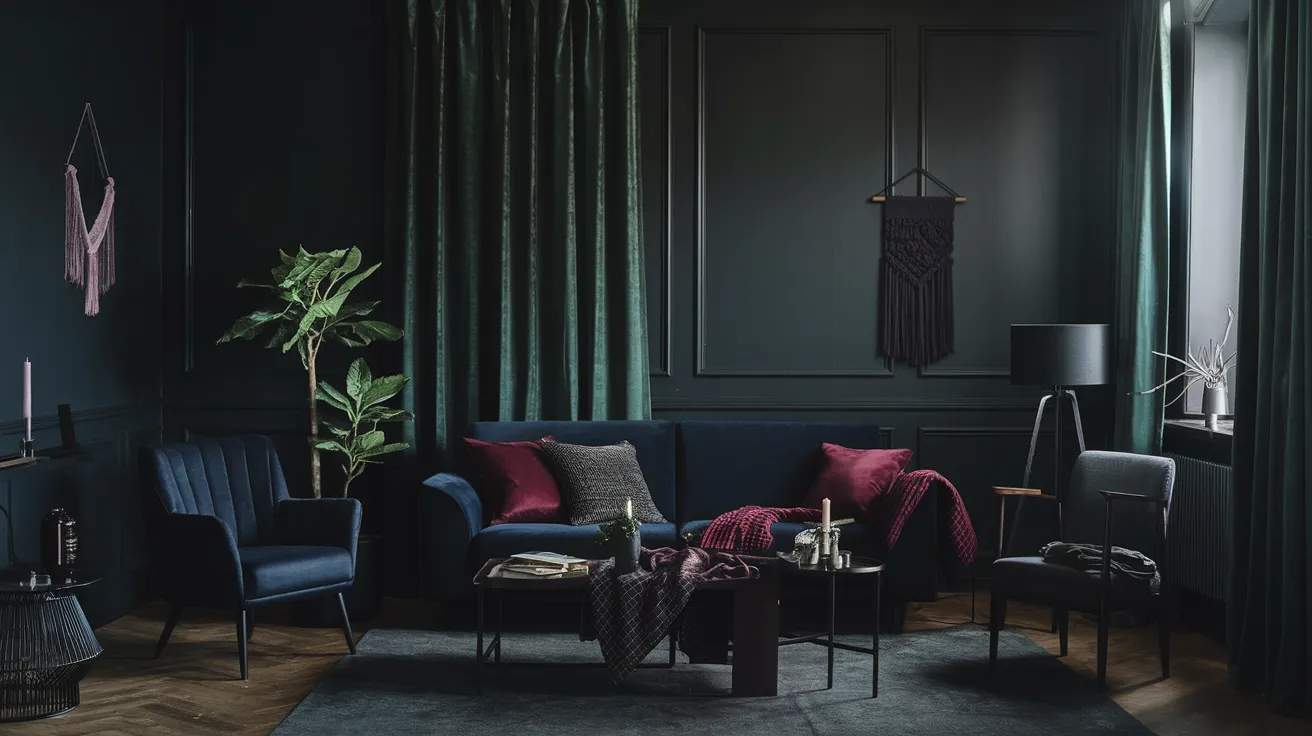
Best Deep Colors for Walls and Large Surfaces
Deep colors form the foundation of moody spaces.
Use rich tones like charcoal, deep navy, forest green, and burgundy for walls and large areas. These colors absorb light rather than reflect it, creating that cozy, intimate feeling that makes these spaces special.
Combining Dark Colors Effectively
When mixing dark colors, work in layers. Pair a deep wall color with slightly lighter furniture, or use similar tones in different textures.
Add small touches of contrast with accessories. This creates interest without making the room feel too heavy or flat.
Tips for Testing Colors in Your Space
Always test colors in your actual room. Paint large samples on different walls and check them throughout the day.
Dark colors look very different under various lighting conditions. Morning light shows colors differently than evening light.
Also, consider your room’s natural brightness – spaces with less sunlight need lighter shades to avoid feeling too closed in.
Maximizing Light in Dark Interiors
Balancing Dark Walls with Proper Lighting
Good lighting is key in dark rooms. Use a mix of light types for balance.
Start with overall room lighting from ceiling fixtures, then add focused lights for reading or cooking areas, and finally, use small lights to highlight art or interesting spots.
This three-part approach creates depth and keeps dark rooms from feeling flat or gloomy.
Mirrors and Reflective Surfaces
Mirrors work magic in dark spaces. Place them across from windows to double natural light.
Add metal items like brass lamps or chrome tables to bounce light around the room. Glass items also help move light through the space.
These shiny surfaces create bright spots that make dark rooms feel more open.
Effective Window Treatments
Window coverings need careful thought in dark rooms.
Pick light-colored, thin fabrics that let sunshine in while keeping privacy. Avoid heavy, dark curtains that block light.
Consider sheer curtains paired with blinds or shades – this gives you control over light and privacy without working against your dark walls.
Adding Visual Interest with Texture and Patterns
Layering Textures for Depth
In dark rooms, textures become even more important than in bright spaces. Mix materials like velvet, leather, and wood to create rooms you want to touch.
Smooth surfaces next to rough ones make each stand out more. Try a soft leather sofa with a knit throw blanket or polished wood tables with clay pottery.
These contrasts add life to dark spaces, keeping them from feeling flat or boring.
Incorporating Patterns
Patterns bring movement and interest to dark walls. Try bold geometric shapes, flower prints, or classic designs that catch the eye.
In dark rooms, patterns can be bigger and more striking without feeling too much.
A patterned rug or wallpaper on one wall can become the focal point that ties the whole room together.
Pick patterns with some lighter tones to create contrast against dark backgrounds.
Creating Cozy Atmospheres with Textures
Soft textures make dark rooms feel warm and inviting. Add velvet pillows, fuzzy rugs, and natural linen to create spaces people want to enter.
Layer different fabrics for a rich feel – smooth sheets under thick knit blankets or silk pillows beside rough woven ones.
These textures catch the light differently, adding subtle brightness to dark spaces while making them feel lived-in and comfortable.
Room-by-Room Dark and Moody Design Tips
Living Room
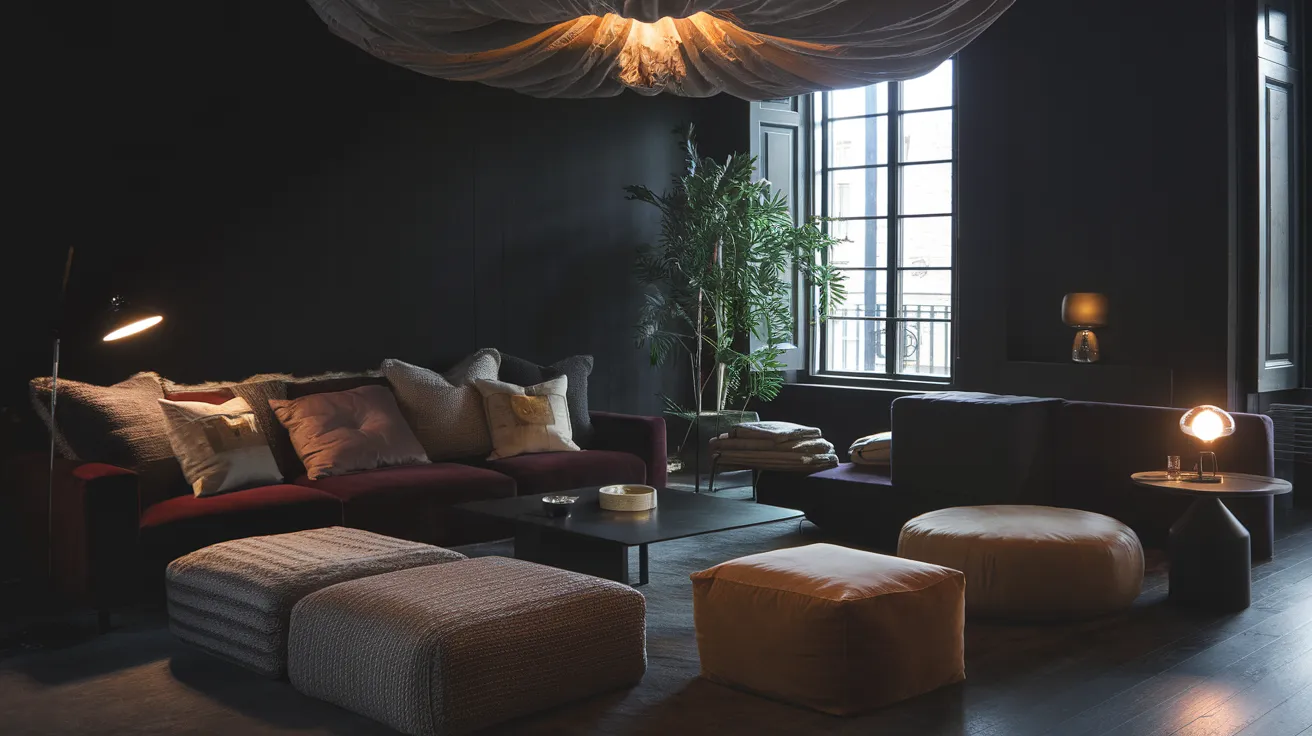
Dark rooms can be perfect for quiet evenings and social gatherings. Choose a deep-colored sofa as your main piece, then add soft cushions in varied textures.
Mix your lighting – use floor lamps behind seating for reading, small table lamps for a smooth glow, and maybe one dramatic ceiling fixture as a focal point.
Keep some items lighter in tone to prevent the room from feeling too heavy. A mix of wood tones and metal accents adds warmth and interest without cluttering the space.
Dining Room
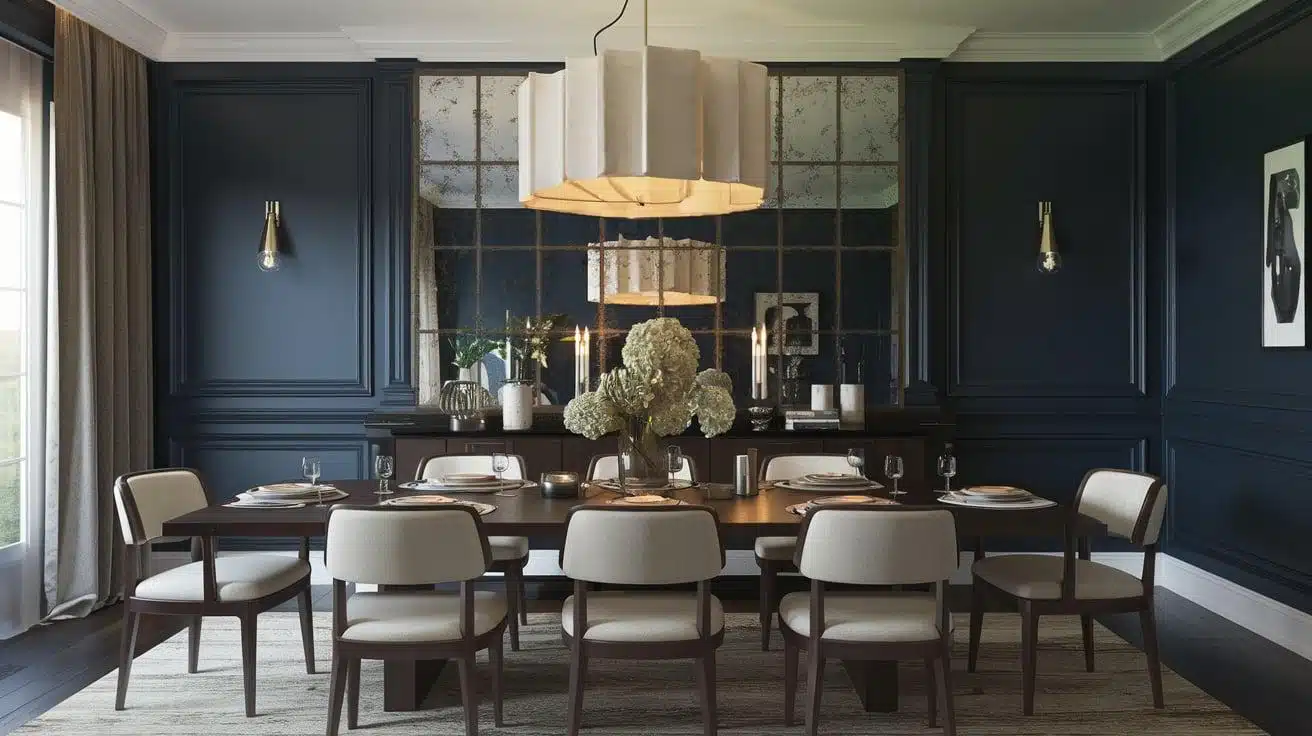
The dining room is ideal for dark and moody styling. Paint deep blues or green walls to create a dramatic background for meals.
A dark wood table with comfortable chairs makes the space feel grounded.
For lighting, hang a statement fixture low over the table – this creates a pool of light that makes guests feel connected while eating.
Add a mirror or two to reflect candlelight during dinner parties for a magical effect that makes everyone look good.
Bedrooms
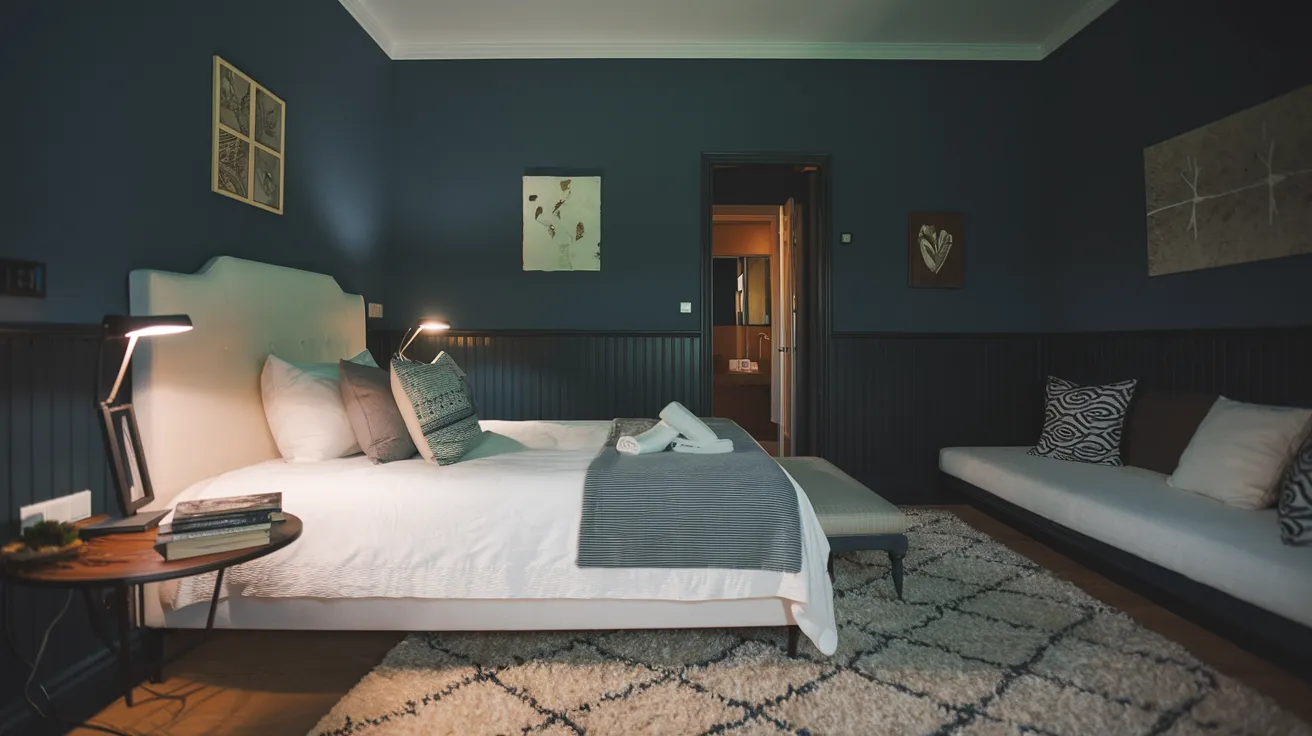
Turn your bedroom into a true retreat with deep wall colors. Dark blues, greens, or even black can create a cocoon-like feeling that helps with sleep.
Balance these with soft bedding in lighter tones – not bright white, but gentle grays or muted colors. Bedside lamps with warm bulbs give you control over the mood.
Add plush rugs, soft throws, and quality pillows for comfort. Keep decor simple and meaningful rather than cluttered.
Small Spaces (Bathrooms, Offices, etc.)
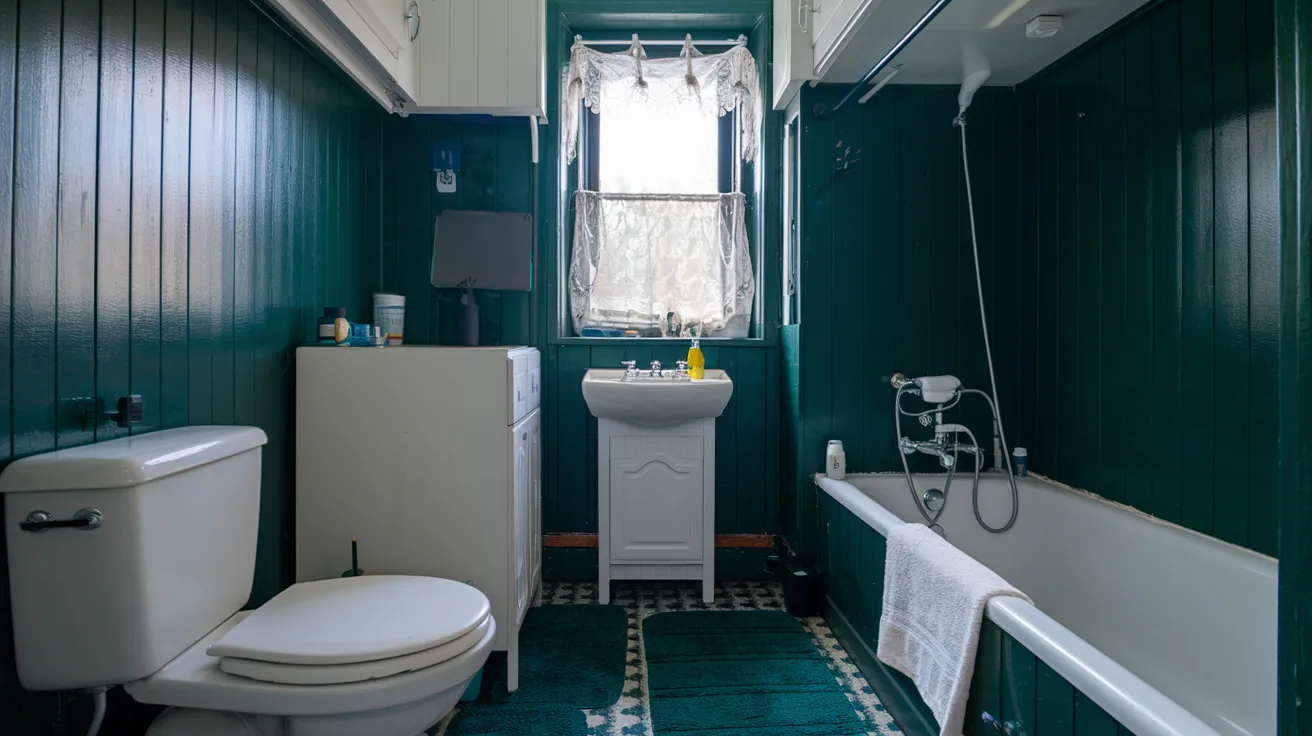
Small rooms often work best with dark colors, contrary to common belief. A tiny deep green or navy bathroom can feel like a jewel box rather than a closet.
In-home offices and dark walls help you focus on your work without boredom. The key in small spaces is keeping items to a minimum and making each count.
Good lighting is essential – make sure task areas have proper lights. Use mirrors and glass to prevent the space from feeling closed in.
Creating Focal Points in Dark Interiors
Accent Walls and Statement Furniture
Dark rooms need clear focal points. Paint one wall in a different deep shade or add texture with limewash or wallpaper.
Choose one standout furniture piece like a curved sofa or unique wooden table. This gives the eye a place to rest without breaking the moody feel.
Art and Decor Elements
Art shines in dark spaces. Select pieces with lighter elements that stand out against dark walls. Choose larger-scale art than you would in bright rooms.
Add small lights above key pieces to highlight them. Group objects thoughtfully rather than scattering them, and focus on interesting shapes that create shadows and depth.
Accessories and Final Touches
Lighting Fixtures
Lighting makes or breaks dark rooms. Choose fixtures with dimmers so you can adjust the mood.
Look for lamps with warm-toned bulbs and designs that cast interesting shadows. Pendant lights with metal interiors bounce light in useful ways.
Wall sconces at eye level create a warm glow that feels inviting. Consider the shape of light each fixture creates—some spread light widely while others focus it in dramatic pools.
Natural Materials
Natural elements bring life to dark spaces. Add wooden items with rich grain patterns that catch light in subtle ways.
Stone surfaces like marble or slate add a cool contrast to soft fabrics. Most importantly, include plants—their green leaves stand out beautifully against dark walls while adding freshness.
For plant pots, choose simple designs that don’t compete with your greenery.
Small Touches
The final layer comes from personal items that make the space yours—group candles of varying heights for light and scent.
Add throws with interesting weaves that invite touch. Include a few vintage items with history and character—old books, brass objects, or small art pieces.
These personal touches modify a styled room into one that feels truly lived-in and connected to you.
Conclusion
Dark interiors succeed through balance—deep colors complemented by strategic lighting and varied textures.
Include statement pieces to create visual interest. Keep spaces organized for a polished look. Start small with a single accent wall or dark furniture if you are hesitant. Gradually expand as comfort grows.
The true value of dark spaces lies in their emotional impact. They create protective spaces that encourage relaxation and introspection in our hectic lives.
These rooms offer a sense of security and personal connection, like a comforting hug.
By welcoming shadow rather than avoiding it, you transform your home into a genuine home from the world outside.














